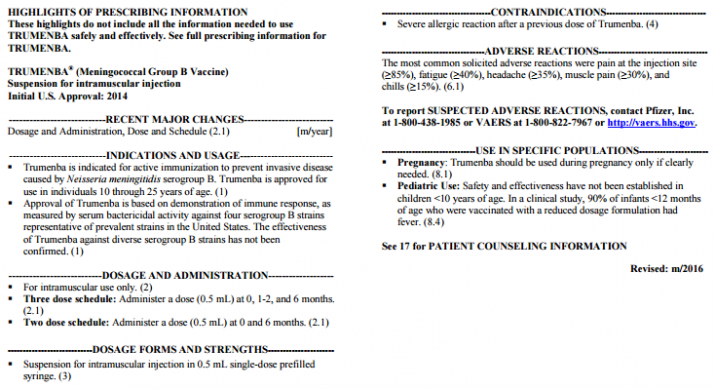
Trumenba: (Meningococcal Group B Vaccine): patient information, prescribing information, ingredients, manufacturer, adverse reactions and side effects
Tuesday, April 11, 2017 by Gregory Van Dyke
http://www.naturalnewsreference.com/2017-04-11-trumenba-meningococcal-group-b-vaccine-patient-information-prescribing-information-ingredients-manufacturer-adverse-reactions-and-side-effects.html

HIGHLIGHTS OF PRESCRIBING INFORMATION
These highlights do not include all the information needed to use TRUMENBA safely and effectively. See full prescribing information for TRUMENBA.
See full insert sheet at this link at the Natural News Reference website.
TRUMENBA® (Meningococcal Group B Vaccine)
Suspension for intramuscular injection
Initial U.S. Approval: 2014
INGREDIENTS AND EXCIPIENTS
Trumenba is a sterile suspension composed of two recombinant lipidated factor H binding protein (fHBP) variants from N. meningitidis serogroup B, one from fHBP subfamily A and one from subfamily B (A05 and B01, respectively). 1 The proteins are individually produced in E. coli. Production strains are grown in defined fermentation growth media to a specific density. The recombinant proteins are extracted from the production strains and purified through a series of column chromatography steps. Polysorbate 80 (PS80) is added to the drug substances and is present in the final drug product.
Each 0.5 mL dose contains 60 micrograms of each fHBP variant (total of 120 micrograms of protein), 0.018 mg of PS80 and 0.25 mg of Al³+ as AlPO4 in 10 mM histidine buffered saline at pH 6.0.
INDICATIONS AND USAGE
Trumenba is indicated for active immunization to prevent invasive disease caused by Neisseria meningitidis serogroup B. Trumenba is approved for use in individuals 10 through 25 years of age. (1)
The effectiveness of the two-dose schedule of Trumenba against diverse N. meningitidis serogroup B strains has not been confirmed. (1)
DOSAGE AND ADMINISTRATION
For intramuscular use only. (2)
Three-dose schedule: Administer a dose (0.5 mL) at 0, 1-2, and 6 months. (2.1)
Two-dose schedule: Administer a dose (0.5 mL) at 0 and 6 months. If the second dose is administered earlier than 6 months after the first dose, a third dose should be administered at least 4 months after the second dose. (2.1)
DOSAGE FORMS AND STRENGTHS
Suspension for intramuscular injection in 0.5 mL single-dose prefilled syringe. (3)
CONTRAINDICATIONS
Severe allergic reaction after a previous dose of Trumenba. (4)
WARNINGS AND PRECAUTIONS
Management of Allergic Reactions
Epinephrine and other appropriate agents used to manage immediate allergic reactions must be immediately available should an acute anaphylactic reaction occur following administration of Trumenba.
Altered Immunocompetence
Individuals with altered immunocompetence may have reduced immune responses to Trumenba
ADVERSE REACTIONS
The most common solicited adverse reactions in adolescents and young adults were pain at the injection site (≥85%), fatigue (≥60%), headache (≥55%), and muscle pain (≥35%). (6)
To report SUSPECTED ADVERSE REACTIONS, contact Pfizer, Inc. at 1-800-438-1985 or VAERS at 1-800-822-7967 or http://vaers.hhs.gov.
USE IN SPECIFIC POPULATIONS
Pregnancy
Risk Summary All pregnancies have a risk of birth defect, loss, or other adverse outcomes. In the U.S. general population, the estimated background risk of major birth defects and miscarriage in clinically recognized pregnancies is 2% to 4% and 15% to 20%, respectively. There are no adequate and well-controlled studies of Trumenba in pregnant women. Available human data on Trumenba administered to pregnant women are insufficient to inform vaccine-associated risks in pregnancy.
Two developmental toxicity studies were performed in female rabbits administered Trumenba prior to mating and during gestation. The dose was 0.5 mL at each occasion (a single human dose is 0.5 mL). These studies revealed no evidence of harm to the fetus or offspring (until weaning) due to Trumenba [see Animal Data].
Animal Data
Two developmental toxicity studies were performed in female rabbits. Animals were administered Trumenba by intramuscular injection 17 days and 4 days prior to mating and on gestation Days 10 and 24. The dose was 0.5 mL at each occasion (a single human dose is 0.5 mL). No adverse effects on pre-weaning development up to post-natal day 21 were observed. There were no fetal malformations or variations observed due to the vaccine.
Lactation
Risk Summary
Available data are not sufficient to assess the effects of Trumenba on the breastfed infant or on milk production/excretion. The developmental and health benefits of breastfeeding should be considered along with the mother’s clinical need for Trumenba and any potential adverse effects on the breastfed child from Trumenba or from the underlying maternal condition. For preventive vaccines, the underlying maternal condition is susceptibility to disease prevented by the vaccine.
Pediatric Use
Safety and effectiveness have not been established in children <10 years of age. In a clinical study, 90% of infants <12 months of age who were vaccinated with a reduced dosage formulation had fever.
Geriatric Use
Safety and effectiveness of Trumenba in adults older than 65 years of age have not been established.
Revised: M/2017
https://www.fda.gov/downloads/BiologicsBloodVaccines/Vaccines/ApprovedProducts/UCM421139.pdf
http://naturalnewsreference.com/vaccine-insert-sheets/Trumenba.pdf
Tagged Under: Tags: dosage, ingredients, insert sheet, side effects, Trumenba, usage, warnings





